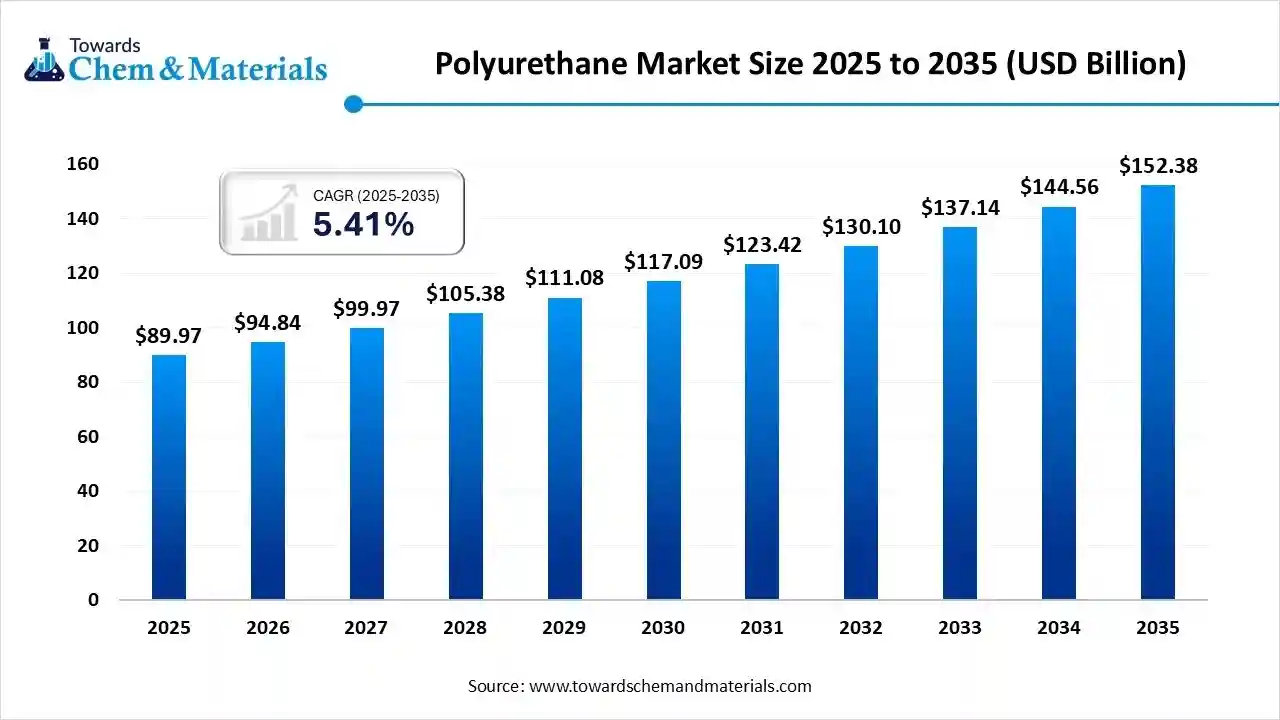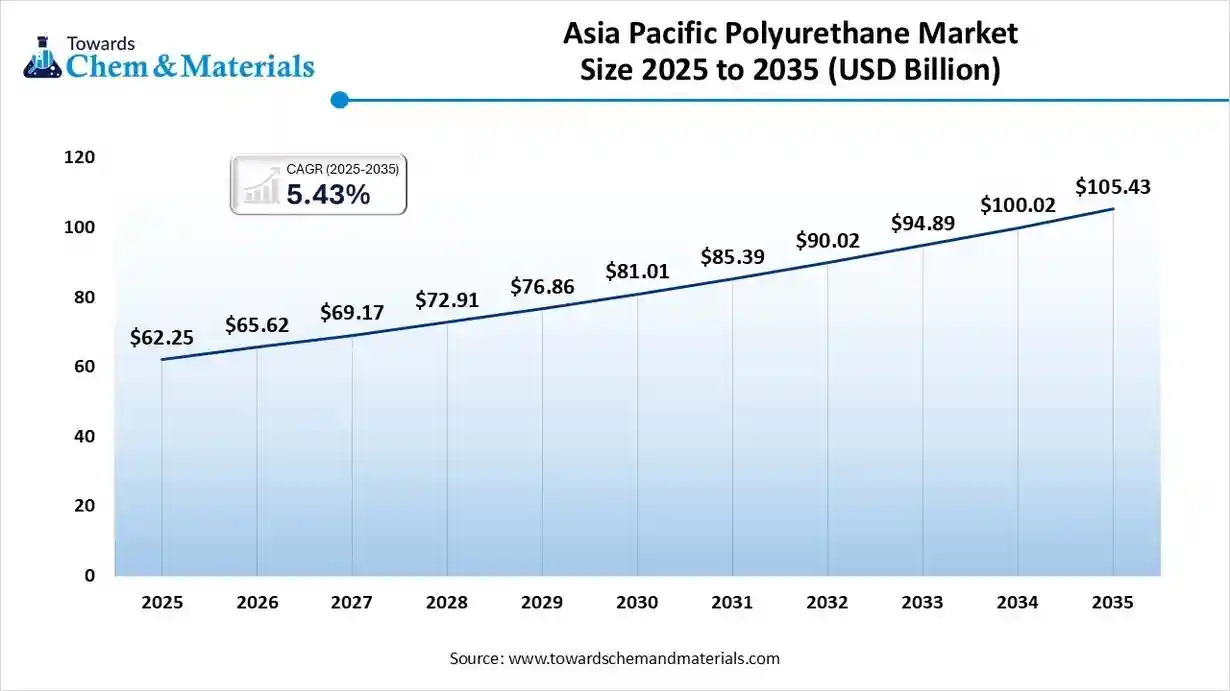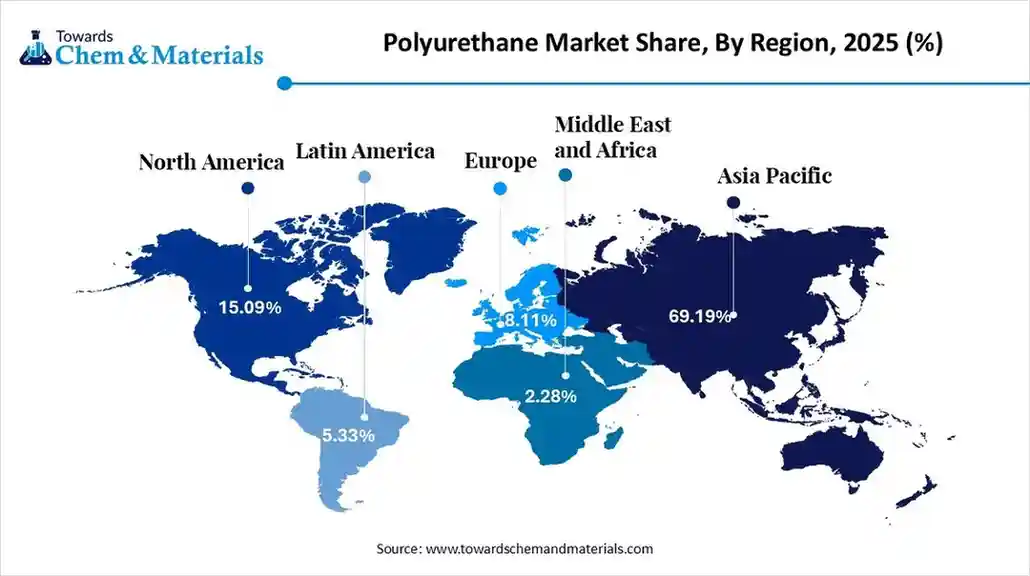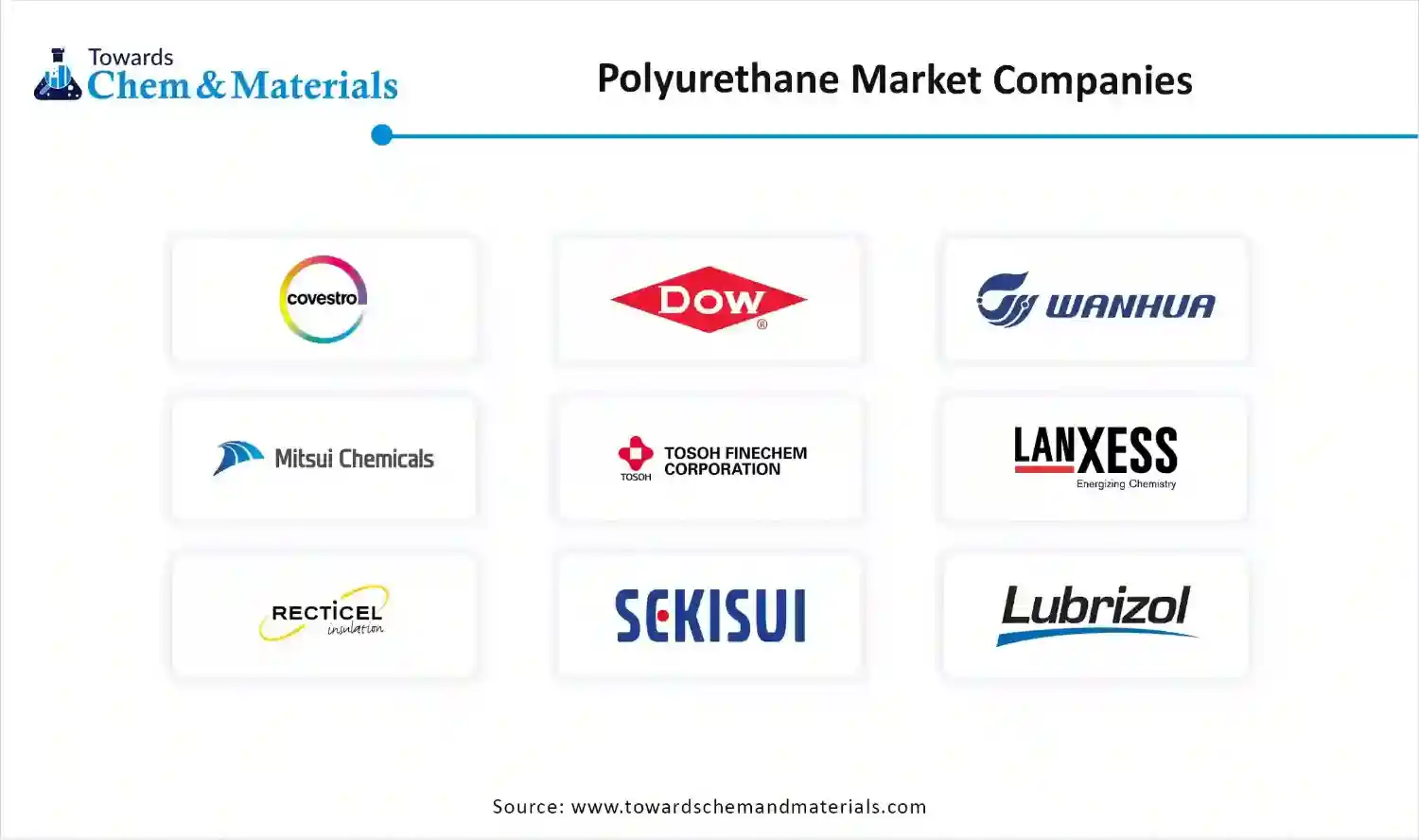November 2025
The global polyurethane market size is calculated at USD 89.97 billion in 2025 and is predicted to increase from USD 94.84 billion in 2026 and is projected to reach around USD 152.38 billion by 2035, The market is expanding at a CAGR of 5.41% between 2026 and 2035. Asia Pacific dominated the polyurethane market with a market share of 69.19% the global market in 2025.The growth of the market is driven by rising demand across the construction, automotive, and furniture industries for durable, lightweight, and versatile materials.

Why is the Polyurethane market experiencing rapid growth?
The polyurethane market is experiencing rapid growth, motivated by its numerous uses in electronics, automobiles, furniture, and construction because of its adaptability and strength. Lightweight polyurethane is a material of choice in many industries. Demand in the market is being further increased by growing infrastructure and urbanization. Innovation in bio-based and eco-friendly polyurethanes is also creating new avenues for growth.
| Trend | Key Insight | Application/Impact |
| Sustainable & Bio-Based PU | Eco-friendly and bio-based polyurethanes are gaining traction due to environmental regulations. | Automotive interiors, packaging, construction, and insulation; lower carbon footprint. |
| Lightweight & high-performance materials | Lightweight foams and elastomers improve fuel efficiency and durability. | Automotive panels, aerospace components, EV battery casings. |
| Advanced Coatings & Adhesives | Rising use for corrosion resistance, weatherproofing, and chemical durability. | Industrial machinery, construction, protective coatings, and sealants. |
| Technological Innovations | Specialty foams, self-healing materials, flame-retardant formulations, expanding market. | Medical devices, electronics, smart textiles, specialty industrial applications. |
| Urbanization & Construction Growth | Insulation, flooring, and roofing solutions in modern infrastructure projects. | Residential and commercial buildings, soundproofing, energy-efficient solutions. |
| Durability & Long Lifecycle Products | High resistance to abrasion, chemicals, and temperature extends product lifespan. | Heavy-use industrial parts, consumer goods, and long-term construction materials. |
| Report Attribute | Details |
| Market Size Value in 2026 | USD 94.84 Billion |
| Revenue Forecast in 2035 | USD 152.38 Billion |
| Growth Rate | CAGR 5.41% |
| Forecast Period | 2026 - 2035 |
| Base Year | 2025 |
| Dominant Region | Asia Pacific |
| Fastest Growing Region | Europe |
| Segments covered | By Raw Material, By Product, By Application, By Region |
| Key companies profiled | Covestro AG, The Dow Chemical Company, Huntsman Corporation, Wanhua Chemical Group Co., Ltd., Mitsui Chemicals Inc., TOSOH CORPORATION, LANXESS AG, Recticel NV/SA, Sekisui Chemical Co., Ltd., The Lubrizol Corporation, Woodbridge Foam Corporation, DIC Corporation |
What Made The Polyols Segment Dominate The Polyurethane Market In 2025?
The polyols material segment dominates the market because they are crucial for creating the rigid and flexible foams used in the packaging, automotive, furniture, and construction industries. They remain the best option for manufacturers due to their affordability and adaptability. The dominance of bio-based polyols is being strengthened by their increasing development.
Methylene diphenyl di-isocyanate segment is the fastest-growing segment because of the growing need for high-performance rigid foams for green building and insulation applications. It is perfect for energy-saving materials due to its exceptional thermal efficiency. MDI consumption is increasing as cold chains and refrigeration infrastructure expand.
Toluene Di-isocyanate segment expects notable growth in the market. Toluene Di-isocyanate is a key raw material for flexible foams used in furniture, bedding, and automotive seating. Growing demands for lightweight materials and comfort are driving demand. Stricter environmental regulations are making w emission TDI variants more important.
What Made The Rigid Foam Segment Dominate The Polyurethane Market In 2025?
Rigid foam segment dominates the market in 2025, because of its superior mechanical strength insulation capabilities and application in cold chain systems, appliances, and construction. It is highly compatible with international emission reduction and energy efficiency standards. Its dominance is supported by growing use in prefabricated and modular buildings. This market is growing due to the increased demand for high-performance insulation boards.
Flexible foam segment is the fastest-growing product driven by the explosive growth in demand for car seats, couches, pillows, and mattresses. For applications that prioritize comfort, its softness, cushioning, and light weight make it indispensable. Flexible foam consumption is rising dramatically due to e-commerce-driven furniture sales. Growth is also being accelerated by the emergence of orthopedic and premium mattress categories.
Coatings segment expects notable growth in the market. Coatings are seeing a notable increase in industries, and architectural and marine applications are used to create long-lasting corrosion-resistant surfaces. The use of solvent-free and waterborne coatings is increasing to lower VOC emissions. This market is a crucial growth area due to its suitability and excellent performance.
What Made The Construction Segment Dominate The Polyurethane Market In 2025?
The construction segment dominates the market in 2025, because PU insulation, sealants, adhesives, and coatings that increase building energy efficiency are frequently used. Its leadership is supported by rapid infrastructure development and urbanization. Government incentives for environmentally friendly construction bolster dominance even more. The market is being further expanded by the use of PU in environmentally friendly wall and roofing systems.
Furniture and Interiors segment is growing rapidly as the market for high-end bedding, modular furniture, and foam products with high resilience grows. Most of this growth is driven by flexible PU foam, which provides exceptional comfort and durability. Rising home renovation and interior design trends add to market expansion. This market is expanding due to the rising demand for luxurious and ergonomic seating options.
The automotive segment is seeing a notable increase due to increasingly increasing use of interiors, seating, and coatings for durability and comfort. Lightweight PU materials improve fuel efficiency and vehicle performance. The EV trend is driving innovative and higher adoption of PU products.
The Asia Pacific polyurethane market size was valued at USD 62.25 billion in 2025 and is expected to surpass around USD 105.43 billion by 2035, expanding at a compound annual growth rate (CAGR) of 5.43% over the forecast period from 2026 to 2035.

Asia Pacific is dominating the market in 2025, because of the furniture, automotive, and consumer goods industries growing demand, robust manufacturing activity, and quick construction expansion. Regional leadership is further reinforced by low production costs and growing industrial capacity. The use of polyurethane in various applications is still increasing due to rapid urbanization. Long-term dominance is also being boosted by extensive housing and infrastructure projects.
China Polyurethane Market Trends
China leads consumption and production due to a robust appliance manufacturing sector, a well-established chemical industry, and enormous construction activity. Demand for PU is driven by rising investments in cold chain facilities and insulation materials. Consistent growth in consumption is supported by a strong government focus on industrial modernization. PU usage is further increased by a significant OEM presence in electronics and automotive
Europe is growing fastest in the market due to strong emphasis on environmentally friendly polyurethane solutions, high adoption of energy-efficient materials, and stringent sustainability regulations. The area is a leader in advanced insulation systems, recycling technologies, and bio-based PU research. Companies are being pushed toward greener formulations by frameworks for the circular economy. Rapid expansion is further supported by growing investments in lightweight materials and clean technologies.
Germany Polyurethane Market Trends
Germany leads the region with strong automotive production, high construction efficiency standards, and growing demand for sustainable insulation. Its cutting-edge chemical sector fosters ongoing PU innovation. Specialty PU grades are consumed more frequently when lightweight vehicle components are used. PU applications are increased by manufacturing improvements and industrial automation. The demand for flexible foam is also influenced by robust bedding and furniture industries.
North America expects the significant growth in the market driven by robust demand in the furniture, automotive, and construction industries. PU adoption has increased due to consumers growing desire for materials that are strong, lightweight, and energy-efficient. In keeping with stringent environmental laws and sustainable trends, the area also prioritizes low-VOC and eco-friendly polyurethane solutions.
U.S. Polyurethane Market Trends
The U.S. dominates the market, backed by a thriving automobile sector and expanding infrastructure initiatives. The market is expanding due to the strong demand for flexible foam coatings and adhesives. Manufacturers are spending more money on cutting-edge PU technologies to satisfy performance and sustainability standards.
The Middle East and Africa polyurethane market is expanding due to increasing construction activities and industrial growth. Rising demand for insulation, coatings, and automotive applications is driving PU consumption. Investment in petrochemical production in the region is also facilitating local PU manufacturing and reducing dependency on imports.

UAE Polyurethane Market Trends
The UAE’s polyurethane market especially PU foam is expanding rapidly, driven by booming construction, real estate, furniture, automotive, packaging, and cold storage demand. Flexible foam dominates consumer oriented segments (furniture, bedding, automotive interiors), while rigid foam is widely used for insulation in buildings, refrigeration systems, and cold chain infrastructure.
The South America polyurethane market is growing steadily. Demand is driven especially by sectors like construction (insulation, building materials), furniture/interiors (foam for mattresses, upholstery), automotive, and appliances, with rigid and flexible polyurethane foams as leading product segments. Overall, South America represents a promising but developing market, with rising infrastructure investment and growing construction/furniture demand underpinning future expansion.
Brazil Polyurethane Market Trends
Brazil's polyurethane market is witnessing steady growth, backed by the growing furniture, construction, and automobile sectors. The adoption of PU is being driven by the need for materials that are affordable, strong, and lightweight. Market opportunities are further increased by government initiatives that support infrastructure development and industrial growth.
Corporate Information
History and Background
Key Developments and Strategic Initiatives
Under a strategy called Winning Ways (announced earlier), BASF is re shaping its portfolio and how it manages its businesses distinguishing between “core” and “standalone” businesses to optimize focus, capital allocation, and operational efficiency.
Mergers & Acquisitions
Partnerships & Collaborations
Product Launches / Innovations
Key Technology Focus Areas
R&D Organisation & Investment
Strengths
Weaknesses
Opportunities
Threats
Recent News & Strategic Updates

By Raw Material
By Product
By Application
By Region
November 2025
November 2025
November 2025
November 2025